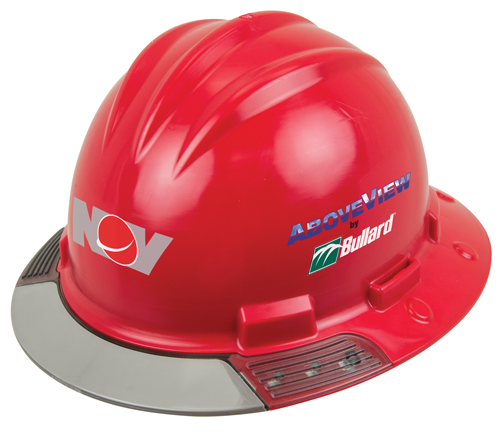Hard hat uses transparent visor to increase workers’ peripheral vision

By Alex Endress, Editorial Coordinator

National Oilwell Varco estimates the AboveView Hard Hat could increase workers’ upper peripheral vision by about 50%. The idea for the hat was hatched during a rig tour in 2009 when an NOV employee was climbing a ladder and bumped into a colleague above him, nearly causing both to fall from 20 ft above the ground
With the multitude of safety-related challenges that workers face in the upstream oil and gas industry, any improvement in a worker’s ability to be aware of their surroundings can make a difference when it comes to keeping themselves and others out of harm’s way. To address this, National Oilwell Varco (NOV) and Bullard are introducing a hard hat designed to increase workers’ upper peripheral vision.
“Think about dropped objects as an example,” said Trey Mebane, Vice President of Innovation at NOV. “People moving about on a rig floor occasionally miss what’s going on in the derrick above them, exposing themselves to this type of danger. In fact, it’s not uncommon to see crew members turn their hard hats backwards or take them off completely in order to see better, leaving them vulnerable to potential hazards.”
To increase visibility for rig workers, NOV has designed the AboveView Hard Hat with an interchangeable transparent visor. The visor is optically true and is estimated to open up workers’ upper peripheral vision by about 50%.

NOV plans to implement the new hats by the end of the year. In order to evaluate its safety benefits compared with traditional hard hats, the company will monitor reportable incident rates with the new hard hats throughout 2017 and compare them with incident rates from previous years. A benchmark survey will be completed with rig crews every three months.
Jed Niederer, Vice President HSE Leadership Development at NOV, came up with the idea while wearing a traditional hard hat during a rig tour in Galena Park, Texas, in February 2009. Mr Niederer was almost 20 ft high in the air climbing a ladder when he bumped into a colleague above him, almost causing them both to fall to the ground. “When I left the rig, I did some research trying to find a hard hat you could see through, but I couldn’t find one,” Mr Niederer recalled.
That night, he sketched a hat and showed his vision to colleagues at NOV. Recognizing an opportunity for improved visibility and safety, the company established a development team including Mr Mebane, co-inventor. By December 2013, the team had received a patent for the hard hat design.
NOV then brought in Bullard, the company that invented the hard hat in 1919, to the project. “We saw the value in bringing this hard hat to other markets, such as utilities or construction, not only oil and gas,” said Stacey Simmons, Product Manager, Industrial Head and Face Protection at Bullard. “Once it has been successfully implemented at NOV, the plan is to launch the hard hat globally.”
NOV plans to implement the new hard hat companywide by year-end, said Drue Ann Whittecar, Director Environmental & Sustainability Engineering at NOV. “The effect on safety is hard to quantify in advance, but it has the potential to impact just about every type of injury occurring on a rig,” she said. NOV plans to monitor reportable incident rates throughout 2017 with the new hard hat in use and will compare it with incidents statistics from previous years.
NOV intends to complete benchmark surveys with rig crews every three months and evaluate the safety benefits achieved. The company has submitted an abstract for the 2017 SPE/IADC Drilling Conference, to be held 14-16 March in The Hague, The Netherlands. The paper would present baseline perceptions from workers using the hard hat. Mr Mebane said NOV also hopes to present future studies comparing later results with the initial baseline.
“We’d like to be able to talk more quantitatively about the impact the hat may have within the operational environment we’re in,” he said. DC
Source: http://www.drillingcontractor.org

